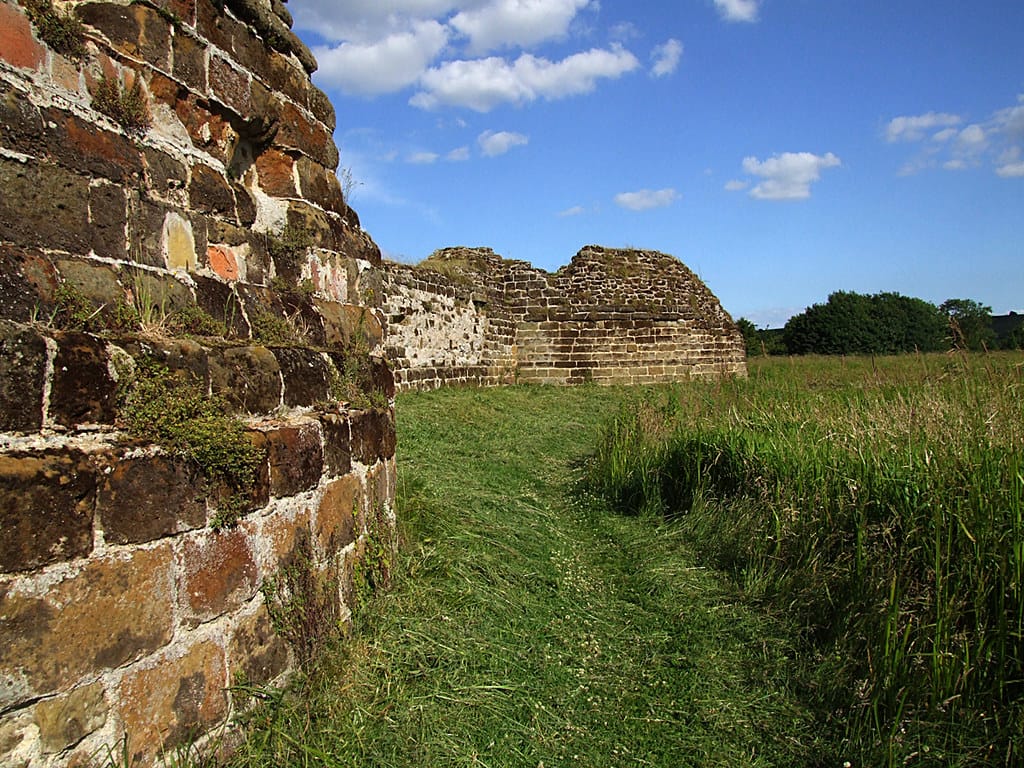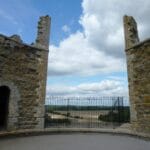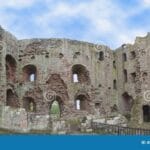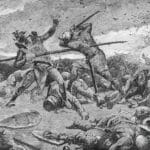Imagine a castle built of stone so weak it almost defies its own survival. That’s Bolingbroke Castle, a Lincolnshire landmark with a history as dramatic as its crumbling walls. From its likely Saxon origins to its pivotal role in the English Civil War, and most famously as the birthplace of King Henry IV, this site echoes with centuries of power, conflict, and fragile beauty. Join us as we explore the secrets of Bolingbroke Castle, uncovering its surprisingly vulnerable structure, its turbulent past, and the ongoing efforts to preserve its legacy.
A Royal Legacy Etched in Stone
Bolingbroke Castle, situated in Lincolnshire, England, isn’t just a collection of old stones; it’s a living testament to English history. Its ruins whisper tales of powerful families, royal births, and the relentless march of time. Let’s delve into its captivating story.
A Fortress Forged from Flawed Foundations
Around 1220, Ranulf de Blundeville, a powerful nobleman, began construction of a formidable castle. His choice of building material, Spilsby greenstone—a local limestone—proved, ironically, to be its greatest weakness. This porous stone readily absorbed water, leading to gradual but relentless decay, a fact likely overlooked by the builders. The resulting hexagonal fortress, impressive in its initial design, would eventually succumb to the very stone it was built from.
John of Gaunt: Transforming a Stronghold into a Palace
By the 14th century, Bolingbroke Castle fell under the ownership of John of Gaunt, the influential Duke of Lancaster. Gaunt didn’t merely occupy the castle; he significantly expanded and transformed it into a grand residence, a symbol of his wealth and power. This transformation marked a shift in the castle’s purpose, elevating its importance beyond a mere defensive structure.
A Royal Cradle: The Birth of Henry IV
The year 1367 witnessed a pivotal moment in Bolingbroke Castle’s history: the birth of Henry IV. This event cemented the castle’s place in English history, forever linking it to one of England’s most famous kings. The castle transcended its physical form, becoming a powerful symbol of royal heritage.
Wars and Wear: A Fortress Under Siege
The Hundred Years’ War and the English Civil War inflicted substantial damage on Bolingbroke Castle. Repeated sieges and battles exacerbated the inherent structural weaknesses of the Spilsby greenstone, accelerating its decay. The Battle of Winceby, in particular, is believed to have inflicted significant damage. The castle, once a symbol of strength, slowly succumbed to the ravages of conflict and time’s relentless erosion.
Unearthing the Past: Archaeological Revelations
Archaeological excavations during the 1960s and 70s revealed fascinating details about daily life within the castle walls. These discoveries offer a glimpse into the lives of the people who lived and worked there, adding a human dimension to the castle’s historical narrative. Research continues, and significant discoveries may yet be made, suggesting that the ground holds more secrets of the castle’s past.
Preserving a Legacy: The Ongoing Fight for Bolingbroke Castle
Since 1995, Heritage Lincolnshire has assumed responsibility for the preservation of Bolingbroke Castle, taking over from English Heritage. This ongoing conservation effort faces immense challenges mirroring those faced by the original builders. However, their dedication ensures that this significant historical site continues to tell its story. [https://www.lolaapp.com/Preserving a Legacy]
What Happened to Bolingbroke Castle? A Slow Decline
Bolingbroke Castle’s demise wasn’t a sudden event but a slow, centuries-long process. Understanding this decline requires examining its long history and the interplay of several factors. [https://www.lolaapp.com/What happened to Bolingbroke Castle?]
From Early Defenses to a Norman Stronghold
Before the grand stone castle emerged, the site likely held strategic importance as early as the 6th or 7th centuries, possibly with simple Saxon defenses. The arrival of the Normans saw the construction of a motte-and-bailey castle, a smaller, more rudimentary fortification that underscores the strategic value of this location.
Ranulf’s Ambitious Undertaking
Ranulf de Blundeville’s ambitious project in the 1220s created the castle most associated with Bolingbroke. Yet, the very Spilsby greenstone chosen for its aesthetic appeal proved ironically fatal. Its porous nature made it intensely vulnerable to water damage, laying the groundwork for the castle’s future decline.
Royal Connections and Daily Life
Throughout its history, the castle changed hands among several noble houses. However, John of Gaunt’s tenure remains particularly significant, not least because his son became King Henry IV. The castle thus became associated with power and royal lineage, making it more than just stones and mortar. Imagining the daily lives of those who inhabited and worked within its walls—cooks, servants, guards—adds vital depth to the castle’s narrative.
An Inevitable Fade
Bolingbroke Castle’s ruin was a gradual process, likely a product of both neglect and the inherent flaws of the Spilsby greenstone. Centuries of exposure to the elements slowly weakened the structure until, by 1815, only ruins remained. However, some historians suggest other potential factors may have contributed to the castle’s decay, and further research could reveal alternative or additional explanations.
Archaeology’s Continued Contribution
Archaeological investigations, beginning in the 1960s and ongoing to this day, continue to peel back the layers of the castle’s past. These digs reveal details about its construction, its inhabitants, and its overall significance. Although only ruins remain, Bolingbroke Castle’s story continues to unfold through ongoing research. Heritage Lincolnshire is dedicated to preserving the remaining structure for future generations. [https://www.lolaapp.com/What Remains: A Silent Witness to History]
What Remains: A Silent Testament
Today, visitors can walk amidst the ruins of Bolingbroke Castle, tangible connections to a time long past. These remnants speak of past grandeur, royal connections, and the enduring human endeavor to commemorate our history. The ruins serve as a powerful reminder of the ephemeral nature of even the mightiest structures.
Which King Was Born at Bolingbroke Castle?
King Henry IV. But the story behind that simple statement is far richer and more complex. [https://www.lolaapp.com/Which king was born at Bolingbroke Castle?]
More Than a Birthplace: Bolingbroke Castle’s Significance
The castle’s significance extends far beyond its association with Henry IV. It likely originated from earlier Saxon fortifications, later evolving into a Norman motte-and-bailey structure in the 12th century. The hexagonal castle we associate with Henry IV’s family is a later iteration, built predominantly of Spilsby greenstone. The use of this aesthetically pleasing but inherently unstable stone remains a point of debate among historians—was it a deliberate architectural choice, or simply a matter of readily available materials? Ongoing research aims to provide a clearer understanding of its construction and design choices.
From Bolingbroke to King: A Turbulent Path to the Throne
Henry Bolingbroke’s journey to the throne was far from straightforward. His claim, based on royal ancestry, sparked a fierce power struggle, culminating in the deposition of Richard II. His subsequent reign, while marked by political achievements and reforms, was continuously challenged by rebellions, including one led by his own son. Ongoing research is constantly refining our understanding of his reign and his complex legacy.
Bolingbroke Castle Today: A Living History
Today, Bolingbroke Castle stands as a testament to time’s relentless passage. Carefully preserved by Heritage Lincolnshire and open to the public, these ruins invite visitors to connect with a rich history, allowing contemplation of centuries of change. The ongoing preservation efforts aim to ensure that the castle’s story continues to resonate with future generations. The questions remain, however, stimulating further academic study and inspiring discussion. [https://www.lolaapp.com/Let’s Summarize: Key Points about Bolingbroke Castle and King Henry IV]
Visiting Bolingbroke Castle
Location: Moat Lane, Spilsby, PE23 4HH, Lincolnshire, England
Accessibility: Wheelchair access (please check for specific details on the Heritage Lincolnshire website)
Admission: Free
For further information and updated details, please visit the Heritage Lincolnshire website. [link to Heritage Lincolnshire website]












